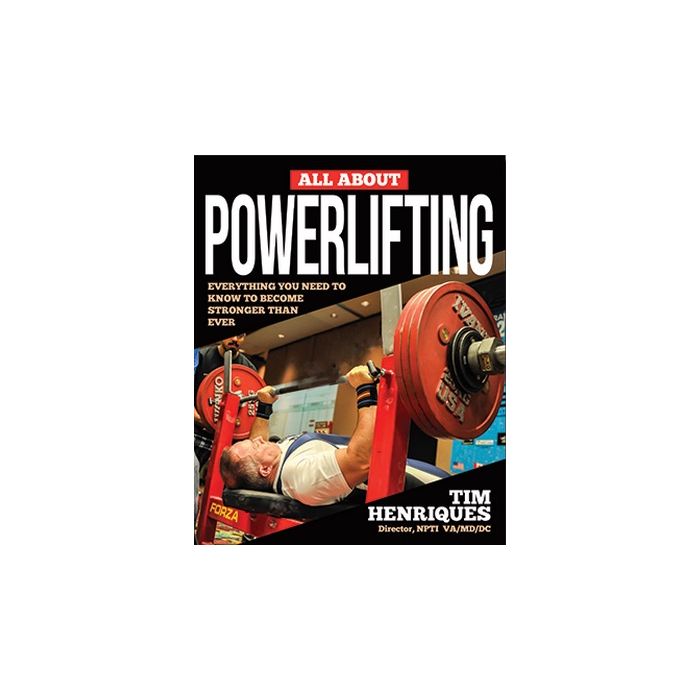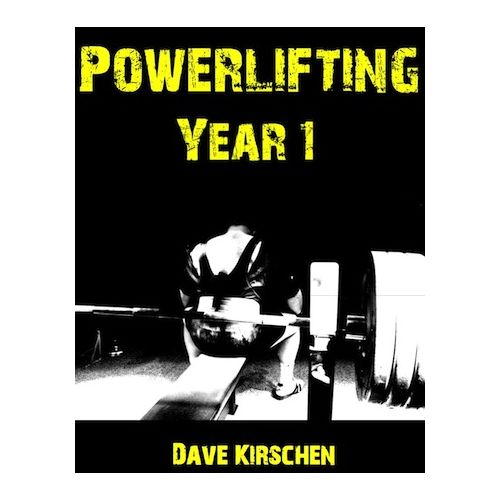All About Powerlifting (eBook)
Everything you need to know to become stronger than ever.
Author: Tim Henriques
Length: 505 pages
All books (hard copy and eBooks) are non-refundable and cannot be exchanged for any other item.
Ships immediately via electronic download. Requires the creation of customer profile for instantaneous access to download library.
By Tim Henriques
505 pages
Powerlifting can test your constitution, discipline, will, and dedication. It can push your body to its limits and show you your best. Strength is the foundation for athletic performance, and powerlifting being wholly devoted to its cultivation can help you reach and break barriers not only on the platform but on the field.
This one of a kind book is dedicated to bringing out the strongest individual you can be, to help you reach new athletic heights, with time tested advice and guidance from some of the best that have ever walked this earth.
Here’s what to expect:
- Learn how to master the competitive lifts
- Detailed strategies and training programs to improve the powerlifts
- The rules of competition
- Extensive nutritional information to help you look and perform your best
- Detailed interviews with some of the strongest men and women to ever walk the planet
- Learn how to manipulate your weight for weigh-ins
- Strategic plans for selecting the proper attempts in a competition
- Learn how to properly warm-up in the gym and in a competition
- Guidelines on how to perform your best on meet day
- Learn how to use powerlifting to improve sporting performance for all sports
- Extensive lifter classification system for each competitive lift for men and women
When you’re ready to discover the strongest person you can be; when you’re ready to climb to the heights of your athletic potential; when you are ready to face your faults, your setbacks, your weaknesses, your fears and transform them into the guiding driving force for your success; let the journey begin here.
Leave nothing on the platform.
Table of Contents
| Acknowledgments | Interview Paul Bossi | Powerlifting Federations |
| Introduction | The Deadlift | Interview with a Meet Director |
| Note about Pictures | Interview Vince Anello | The Strict Curl |
| Table of Contents | Increasing the Deadlift | Appendix Outline |
| What is Powerlifting | Interview Sioux-z Hartwig Gary | Appendix A – FAQ |
| History of Powerlifting | Powerlifting Program Design | Appendix B – Newbie Mistakes |
| The Squat | Powerlifting for Other Athletes | Appendix C – Recommended Readings |
| Interview Kirk Karwoski | Conditioning and Supplemental Exercises | Appendix D – PL Websites |
| Increasing the Squat | General Nutrition Information | Appendix E – Female Lifter Classifications |
| Interview Wade Hooper | Changing Weight | Appendix F – Male Lifter Classifications |
| The Bench Press | Powerlifting Competitions | Appendix G – Lifter Classification Information |
| Interview Jennifer Thompson | How to warm-up for attempts | Appendix H – Tim Henriques PL Career |
| Jennifer Thompson Workout Spreadsheet | How to select attempts | Appendix I – You know you are a PLer when… |
| Increasing the Bench Press | Powerlifting Gear | Appendix J – The Future |
Short excerpts from the book
Chapter 4 – Increasing the Squat
The squat is a brutal exercise, no doubt about it. When you perform a tough squat workout or go into a competition, you must be mentally ready for it. Once you decide that you are going to complete that workout or that set, you pretty much need to have a do or die attitude. The squat is a relatively high skill exercise. You need to have some control of your rage, otherwise your energy will …..
Chapter 5 – The Bench Press
….As you are pressing the bar upward you may find that you have increased strength if you press the bar upwards and backwards slightly, so the bar travels in an arc going back up over your head. If the bar begins at the middle of your chest, as you press it up if you also move it slightly back the bar will end up over your upper chest or your clavicle. This arc should not be excessive but should follow a natural range of motion….
Chapter 7 – The Deadlift
The deadlift is one of the coolest exercises there is. It is so simple. There is a weight, bend down, pick it up, and stand up straight with it. Yet it is so grueling. Much like a tough set of squats, completing a brutal set of deadlifts will leave you gasping for breath and seeing stars. The deadlift is the simplest of the big three exercises, meaning it requires the least amount of skill. The deadlift is the most natural of the 3 lifts. Essentially all people, regardless of age, will perform a deadlift during their day basically every day. Every time you bend down to pick something up on the ground, from your shoes to your laundry basket to a child to your dog to your couch, if you pick something up you are deadlifting it. In addition your ability to deadlift….
Chapter 9 – Program Design
The first thing to know when selecting your next program is where are you now? To keep this simple there are 3 phases to choose from, each one should be pretty straight forward:
Phase 1: Post competition – off season, or recovering from an injury
There is a saying that there is no off season in powerlifting and there is some truth to that, but at the same time you can’t just continually peak for a meet for 10 years straight. After a competition, especially as your level of advancement increases, you may want to back things off a bit. In addition if you are recovering from some sort of injury and you need to go a bit lighter, this is your phase.
Phase 2: General Strength Training
This is the phase that most lifters spend most of their training time in. They are training to get bigger and stronger but there isn’t a meet right around the corner that they are prepping for.
Phase 3: Peaking Phase
This is when a lifter registers for a competition that is usually 6-12 weeks out and they design a program to get them ready to hit the best possible 1RM’s on that day. The idea is to peak in strength and thus to maximize performance on the day of the competition.
There are specific workout programs available tailored to each one of these phases outlined below…
Chapter 10 – Powerlifting for other Athletes
Most athletes know that they should lift weights – I think that battle has been won. Now the question becomes, what kind of program should I follow? This is where there is still much confusion on the issue. Chances are that the athletic ability you are demonstrating on the court or field requires a reasonable amount of skill (almost all sports are high skill activities, which is why it takes years to be good at them). It should be logical, then, that you want to perform activities in the gym that are relatively high skill. If getting better in the bench press….
Chapter 13 – Changing Weight
If you have 18 or more hours to rehydrate then you can use slightly more drastic measures to lose the water. I want to be clear from the outset that I am not advocating these methods as being healthy or “good for you”, they are simply a means to an end. I don’t think there is enough information on either side of the equation to declare them as either good or bad, although clearly one can lose water the wrong way and end up with harmful and/or negative results.Generally if the goal is to manipulate one’s water level it is a two stage process. The first stage is approximately a week long. The second stage is done right before the actual weigh-in….
Chapter 14 – The Day of the Meet
The purpose of this chapter is to help you, the lifter, be as prepared as possible on the day of the meet. Being prepared can help alleviate some (not all) of the nerves that are common pre-meet, and the more experience you acquire the more routine the meets will become. It is very easy as a novice to forget to bring something important; to not know an important rule; or just to be….
Chapter 15 – Warming Up
Once you have completed that beginning part of the specific warm-up, you then ask yourself what weight are you going to use on your work sets? Think about the difference in the weight you just lifted and what you are planning to lift. Ask yourself how many more warm-up sets you will need to feel ready to lift that weight? Decide how many warm-up sets you want to use and break up the weight….












